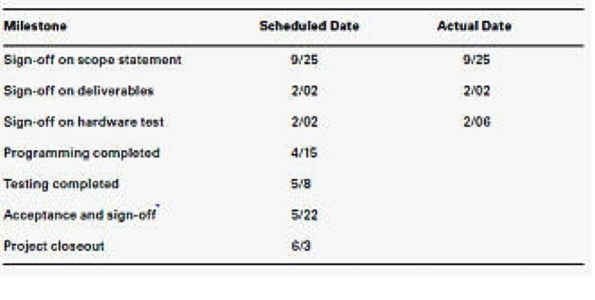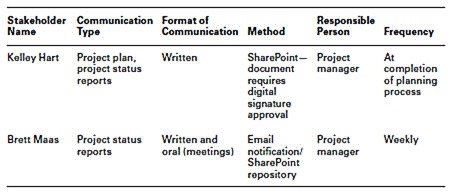Project Schedule:
A Milestone marks a key event in the project life cycle or the completion of a major deliverable.
A Milestone Chart tracks the scheduled dates and actual completion dates for the major milestones.

Gantt Chart: It is a method used to display the project schedule and it shows milestones, deliverables, sub-deliverables, or all project activities. Gantt charts are also easy to read and can show the activity sequences, start and end dates, resource assignment, dependencies, and critical path.
Mandatory Dependency: Is defined by the type of work being performed, and one activity is dependent on another activity.
Discretionary Dependency: Is usually process or procedure-driven and may include best-practice techniques.
External Dependency: a relationship between a project task and some factor outside the project that drives the scheduling of that task
Critical Path: The critical path is the longest full path on the project.
Schedule Baselines: The final, approved version of the project schedule that includes the baseline start and finish dates and resource assignments. Baselines are also used to monitor progress throughout project.

Method:
Program Evaluation and Review Technique (PERT): A way to manage the project and forecast the project schedule with a high degree of reliability. It uses expected value.
Expected value = (optimistic + pessimistic + (4 x most likely)) /6
Methods:
- Top-down estimating: The use of actual durations from similar activities on a previous project.
- Expert judgment: Uses people familiar with project work to create the estimate.
- Parametric estimating: Method that multiplies the quantity of the work by the rate.
- Three-point estimates: Average of the most likely estimate, the optimistic estimate and the pessimistic estimate.
Critical Path Method (CPM): Determines the amount of float time for each activity on the schedule by calculating the earliest start date, earliest finish date, latest start date, and latest finish date for each. It is the longest path in the project.
Graphical Evaluation and Review Technique (GERT): Allows conditional loops in the project schedule as well.
Network diagram (ADM, PDM, CDM, CCM): Depicts the project activities and the interrelationships among these activities.
Arrow Diagramming Method (ADM): The arrows represent activities and the nodes are the connecting points between activities.
Precedence Diagramming Method (ADM): Uses boxes to represent the project activities and arrows to connect the boxes and shows the dependencies.
Conditional Diagramming Method (CDM): A method to diagram activities that loop, or are repeated throughout the project; used with GERT.
Critical Chain Method (CCM): Adds time buffers to the end of CPM.
TestMoz:
Click here to take a test on this chapter.
